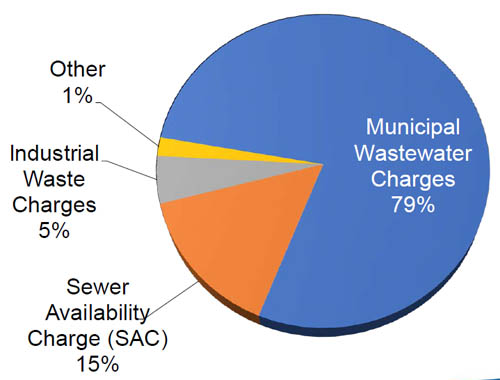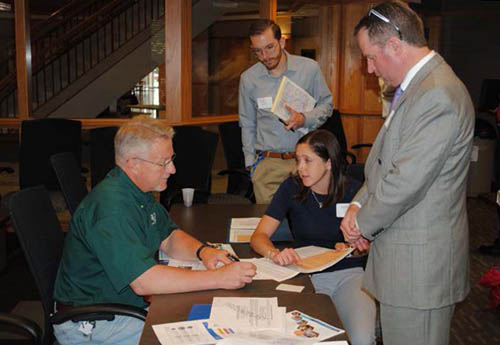The overall charge to communities for regional wastewater collection and treatment will go up 3.7% in 2018. That rate meets the Metropolitan Council’s goal to keep annual increases in the municipal wastewater charge at 4% or below.
Ned Smith, Director of Finance for MCES, explained that most communities will not see its rate go up exactly 3.7%; some communities will see a larger increase and others smaller. It all depends on a community’s measured flow relative to all the wastewater that enters the regional system.
Capital program drives rate increase
 The biggest driver of the increase is paying the debt for the Environmental Services division’s (MCES) capital improvement program. MCES has a systematic, ongoing program to expand and rehabilitate portions of the 600+ miles of large regional sewer interceptor pipes and other wastewater collection and treatment facilities in the seven-county metro. About 85% of that effort goes to preservation of existing assets.
The biggest driver of the increase is paying the debt for the Environmental Services division’s (MCES) capital improvement program. MCES has a systematic, ongoing program to expand and rehabilitate portions of the 600+ miles of large regional sewer interceptor pipes and other wastewater collection and treatment facilities in the seven-county metro. About 85% of that effort goes to preservation of existing assets.
Debt service is rising $7 million from 2017 to 2018, about 90% of the total increase in the municipal wastewater charge. “We are in the lowest third of our peer agencies in terms of debt service per capita,” Smith said. “We feel pretty comfortable about that.”
Retail customers are getting a good deal for their money
Retail customers in the Twin Cities metro area pay 40% less for wastewater services, on average, than other peer metro areas in the U.S., according to the most current data from the National Association of Clean Water Agencies, Smith said.
The sewer availability charge, or SAC, will stay flat at $2,485 for the fifth year. SAC is a one-time fee a residence or business pays when it connects to the regional wastewater system for the first time, or when a business grows or changes the uses of its space, resulting in more potential demand on the system.
The industrial strength charge will go up 6.8%, part of a five-year strategy to gradually incorporate the cost of capital improvements into the strength charges.
Council increases engagement with municipal and industrial customers
 This year, MCES staff held three listening sessions for communities in the spring, prior to setting preliminary municipal wastewater charges. The goal, Smith said, was to share information about:
This year, MCES staff held three listening sessions for communities in the spring, prior to setting preliminary municipal wastewater charges. The goal, Smith said, was to share information about:
-
The level of service that customers can expect from MCES
-
How rates are set and what communities can do to lower their rates
-
MCES’s capital improvement program
-
Plans to improve customer service
Just as importantly, MCES wanted to hear feedback and get ideas from the communities about how to continue to improve service.
Many improvements were made for the 2017 rate-setting process. For example, MCES produced fact sheets on topics such as SAC, inflow and infiltration, and how rates are set. Last year, community representatives had requested the information in a form they could share with their elected officials.
 The Council issued preliminary estimates to the 109 communities it serves in May so they could use that information in building their own budgets, Smith said.
The Council issued preliminary estimates to the 109 communities it serves in May so they could use that information in building their own budgets, Smith said.
At a forum for industrial customers held in April, staff shared information in concurrent sessions about industrial waste procedures, electronic reporting, finance and capital projects. Staff solicited ideas for improvements from customers. A record 53 customers attended the forum.
“We heard a lot of positive feedback about how engaging the listening sessions and forum were,” Smith said, “and we learned things that we can use to improve our service and customer interactions.”
The Council also held two budget forums after the preliminary rates were set. At the budget forums, staff were available to talk with individual cities about their charges, how flow is measured, and other information.
“This is really smart work,” said Council Member Sandy Rummel, chair of the Council’s Environment Committee. “The organizing you did sounds terrific.”
Wastewater operations funded entirely by user fees
The Council’s wastewater operations are funded entirely by user fees, of which the municipal wastewater charge is the largest contributor – about 79% of total revenue. The sewer availability charge (SAC) is another 15%; industrial waste charges are 5%, with 1% coming from investment earnings, state appropriations and other sources. Total revenue for 2018 is projected to be $278.7 million.
MCES will use $2.2 million in reserves to keep the municipal wastewater charge increase to 3.7% in 2018.
More information